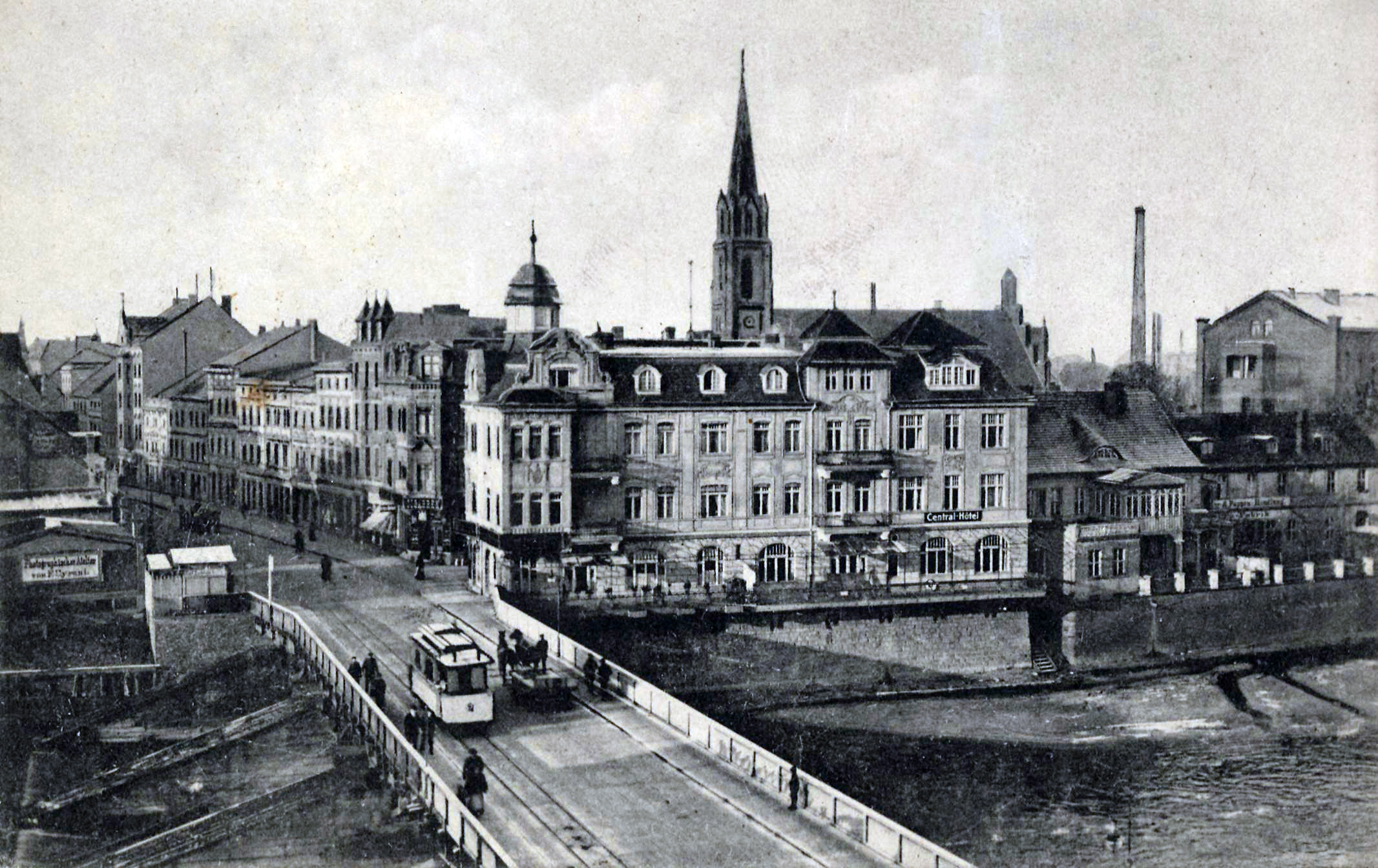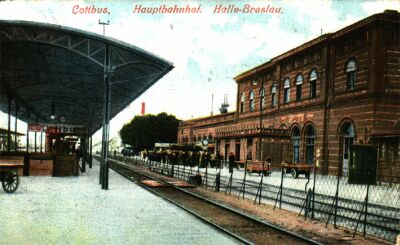|
Cottbus–Guben Railway
The Cottbus–Guben railway is a two-track electrified main line in the Southeast of the German state of Brandenburg. It connects the city of Cottbus with the town of Guben, which is on the German–Polish border and the Lusatian Neisse. The line is served every hour by Regional-Express service RE 11, which connects Cottbus station, Cottbus, Guben station, Guben and continues towards Eisenhüttenstadt and Frankfurt (Oder) station, Frankfurt (Oder). Starting in 2002, parts of the line were rerouted in the Cottbus area to allow the expansion of the Cottbus-Nord lignite mine. History The line was the first part of the network of the Halle-Sorau-Guben Railway Company (german: Halle-Sorau-Gubener Eisenbahn-Gesellschaft, HSGE), which was opened to traffic on 1 September 1871. With the Guben–Zbąszynek railway, railway between Guben and Bentschen (now Zbąszynek), which had been completed one year earlier, it was part of a direct connection between Poznań and Cottbus. With the expan ... [...More Info...] [...Related Items...] OR: [Wikipedia] [Google] [Baidu] |
15 KV AC Railway Electrification
Railway electrification systems using at are used on transport railways in Germany, Austria, Switzerland, Sweden, and Norway. The high voltage enables high power transmission with the lower frequency reducing the losses of the traction motors that were available at the beginning of the 20th century. Railway electrification in late 20th century tends to use AC systems which has become the preferred standard for new railway electrifications but extensions of the existing networks are not completely unlikely. In particular, the Gotthard Base Tunnel (opened on 1 June 2016) still uses 15 kV, 16.7 Hz electrification. Due to high conversion costs, it is unlikely that existing systems will be converted to despite the fact that this would reduce the weight of the on-board step-down transformers to one third that of the present devices. History The first electrified railways used series-wound DC motors, first at 600 V and then 1,500 V. Areas with 3 kV ... [...More Info...] [...Related Items...] OR: [Wikipedia] [Google] [Baidu] |
Teichland
Teichland ( dsb, Gatojce, ) is a municipality in the district of Spree-Neiße, in Lower Lusatia, Brandenburg, Germany. History The municipality of Teichland was formed on 31 December 2000 by merging the municipalities of Bärenbrück, Maust and Neuendorf. From 1815 to 1947, the constituent localities of Teichland were part of the Prussian Province of Brandenburg. After World War II, Bärenbrück, Maust and Neuendorf were incorporated into the State of Brandenburg from 1947 to 1952 and the Bezirk Cottbus of East Germany East Germany, officially the German Democratic Republic (GDR; german: Deutsche Demokratische Republik, , DDR, ), was a country that existed from its creation on 7 October 1949 until its dissolution on 3 October 1990. In these years the state ... from 1952 to 1990. Since 1990, they have been part of Brandenburg, since 2000 united as the municipality of Teichland. Demography References Populated places in Spree-Neiße {{Brandenburg-geo-stu ... [...More Info...] [...Related Items...] OR: [Wikipedia] [Google] [Baidu] |
Lusatian Neisse
The Lusatian Neisse (german: Lausitzer Neiße; pl, Nysa Łużycka; cs, Lužická Nisa; Upper Sorbian: ''Łužiska Nysa''; Lower Sorbian: ''Łužyska Nysa''), or Western Neisse, is a river in northern Central Europe.''Neisse River'' at www.britannica.com. Retrieved 4 Feb 2011. at http://eagri.cz/public. Retrieved 4 Feb 2011. It rises in the , near |
Guben
Guben (Polish and Sorbian: ''Gubin'') is a town on the Lusatian Neisse river in Lower Lusatia, in the state of Brandenburg, Germany. Located in the Spree-Neiße district, Guben has a population of 20,049. Along with Frankfurt (Oder) and Görlitz, Guben is a divided city on the border between Germany and Poland, having been separated into Guben and Gubin in 1945 by the Oder–Neisse line. Geography Environment Guben is located in the district (Landkreis) of Spree-Neiße in the southeast of the state of Brandenburg. It is in the historical region of Lower Lusatia. Guben's position on the banks of the Lusatian Neisse between two plateaus was advantageous in its early economic development. These plateaus developed from ground moraines of the Wisconsin glaciation period. Both the western (''Kaltenborner Berge'' = Kaltenborn Hills) and eastern (''Gubener Berge'' = Guben Hills) ended up as terminal moraines. The surrounding land is covered with pine forests and lakes. Districts ... [...More Info...] [...Related Items...] OR: [Wikipedia] [Google] [Baidu] |
Cottbus
Cottbus (; Lower Sorbian: ''Chóśebuz'' ; Polish: Chociebuż) is a university city and the second-largest city in Brandenburg, Germany. Situated around southeast of Berlin, on the River Spree, Cottbus is also a major railway junction with extensive sidings/depots. Although only a small Sorbian minority lives in Cottbus itself, the city is considered as the political and cultural center of the Sorbs in Lower Lusatia. Spelling Until the beginning of the 20th century, the spelling of the city's name was disputed. In Berlin, the spelling "Kottbus" was preferred, and it is still used for the capital's ("Cottbus Gate"), but locally the traditional spelling "Cottbus" (which defies standard German-language rules) was preferred, and it is now used in most circumstances. Because the official spelling used locally before the spelling reforms of 1996 had contravened even the standardized spelling rules already in place, the (german: Ständiger Ausschuss für geographische Namen) stre ... [...More Info...] [...Related Items...] OR: [Wikipedia] [Google] [Baidu] |
Halle–Cottbus Railway
The Halle–Cottbus railway is a 176 km long double-track electrified main line in the German states of Saxony-Anhalt, Saxony and Brandenburg. It was opened in 1871 and 1872. It formed the central section of the network of the Halle-Sorau-Guben Railway Company. Today it is part of a connection between the Central Germany and Poland. Before German reunification, the line was also served by express trains, but it is now mainly used by regional and international freight traffic. History On 1 December 1871, the Halle-Sorau-Guben Railway Company (''Halle-Sorau-Gubener Eisenbahn'', HSGE) opened the Cottbus–Falkenberg/Elster section after its extension towards Guben was opened earlier the same year. Six months later, on 1 May 1872, trains ran via Falkenberg to Eilenburg and, two more months later, on 30 June 1872, operations on the line were extended as far as Halle. It did not connect with many of the former Prussian private railways that it crossed, as there were no at-gr ... [...More Info...] [...Related Items...] OR: [Wikipedia] [Google] [Baidu] |
Großenhain–Cottbus Railway
The Großenhain–Cottbus railway is an electrified main railway in the German states of Saxony and Brandenburg. It is double track between Cottbus station, Cottbus and Ruhland station, Ruhland and elsewhere single-track. It runs from Großenhain via Ruhland and Senftenberg station, Senftenberg to Cottbus. History The Großenhain–Cottbus line was built by the Cottbus-Großenhain Railway Company (german: Cottbus-Großenhainer Eisenbahn-Gesellschaft). The Großenhain–Cottbus line was opened on 20 April 1870. With the subsequent opening of the Berlin–Dresden railway, Großenhain had two railway stations. The existing station on the line to Cottbus was renamed Großenhain Cottbuser station, Großenhain Cottbuser Bahnhof and the new station was named Großenhain Berlin station, Großenhain Berliner Bahnhof. The end of the runway of the Großenhain military airfield used to be shortly east of Großenhain station towards Lampertswalde. Therefore, in the period between the elect ... [...More Info...] [...Related Items...] OR: [Wikipedia] [Google] [Baidu] |
Cottbus Station
Cottbus Hauptbahnhof is one of the main railway stations of the German state of Brandenburg. It was called Cottbus station until 9 December 2018. It is located just south of central Cottbus. It is classified by Deutsche Bahn as a category 2 station. History Cottbus station entered into operation on 13 September 1866 with the opening of the railway line from Berlin. In 1867, this line was extended to Görlitz. In 1870, the station building was inaugurated, located between the tracks as an "island station" (german: Inselbahnhof). In the following years, other railway lines were built in the region. The ''Großenhainer Bahnhof'' (the station serving trains to Großenhain) was opened on the Großenhain–Cottbus railway in 1873, north of the ''Berliner Bahnhof'' (the station serving trains to Berlin). In 1880, this station was closed and the trains were diverted to the Berlin station. The building of the ''Großenhainer Bahnhof'' still exists and serves the railway administratio ... [...More Info...] [...Related Items...] OR: [Wikipedia] [Google] [Baidu] |
Berlin–Görlitz Railway
The Berlin–Görlitz railway is a main line railway in the German states of Berlin, Brandenburg and Saxony, which was originally built and operated by the Berlin-Görlitz Railway Company (''Berlin-Görlitzer Eisenbahn-Gesellschaft''). The line runs through Lusatia from Berlin via Cottbus to Görlitz. It is one of the oldest lines in Germany, opened in 1866 and 1867. It was nationalised in 1882 and became part of Prussian state railways. In 1920, it became part of German national railways along with the rest of the Prussian state railways. Route The line runs from Berlin via Königs Wusterhausen, Lübben, Cottbus, Spremberg, Weißwasser and Horka to Görlitz. The route originally began in Berlin from Görlitz station, a terminal station that was demolished in 1962. Today, the line starts at the Berlin Stadtbahn and the Ringbahn and passes through the southeastern landscapes of the Spreewald and Lower Lusatia to the railway junction of Görlitz. The line is double-tracked onl ... [...More Info...] [...Related Items...] OR: [Wikipedia] [Google] [Baidu] |
Spree (river)
The Spree ( ; wen, Sprjewja, cs, Spréva) is, with a length of approximately , the main tributary of the River Havel. The Spree is much longer than the Havel, which it flows into at Berlin-Spandau; the Havel then flows into the Elbe at Havelberg. The river rises in the Lusatian Highlands, that are part of the Sudetes, in the Lusatian part of Saxony, where it has three sources: the historical one called ''Spreeborn'' in the village of Spreedorf, the water-richest one in Neugersdorf, and the highest elevated one in Eibau. The Spree then flows northwards through Upper and Lower Lusatia, where it crosses the border between Saxony and Brandenburg. After passing through Cottbus, it forms the Spree Forest, a large inland delta and biosphere reserve. It then flows through Lake Schwielochsee before entering Berlin, as '' Müggelspree'' The Spree is the main river of Berlin, Brandenburg, Lusatia, and the settlement area of the Sorbs, who call the River Sprjewja. For a very short d ... [...More Info...] [...Related Items...] OR: [Wikipedia] [Google] [Baidu] |
Cottbus-Sandow Station
Cottbus-Sandow station is a railway station in the Sandow district in the town of Cottbus, located in Brandenburg, Germany. References External links {{Authority control Railway stations in Brandenburg Buildings and structures in Cottbus ... [...More Info...] [...Related Items...] OR: [Wikipedia] [Google] [Baidu] |



.jpg)


